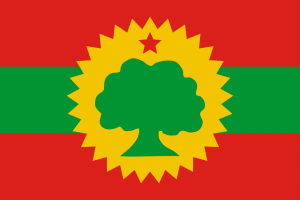Language/Borana-arsi-guji-oromo/Culture/Wedding-Attire
Introduction
Wedding ceremonies in the Borana-Arsi-Guji Oromo culture are deeply traditional events involving various customs, rituals, and celebrations, including the attire worn by the bride and groom. In this lesson, we will explore the traditional wedding attire worn by the bride, groom, and guests during Borana-Arsi-Guji Oromo weddings.
Borana-Arsi-Guji Oromo Wedding Attire
Borana-Arsi-Guji Oromo wedding attire is heavily influenced by the culture and traditions of the Oromo people, including their beliefs and customs related to life transitions and family ceremonies. The elaborate and vibrant wedding attire worn by the bride and groom, as well as the guests, reflect the rich cultural and artistic heritage of the Oromo people.
Bride's Attire
The bride's wedding attire is one of the most striking and intricate aspects of Borana-Arsi-Guji Oromo weddings. The bride's dress is usually made of colorful fabrics, such as dabsa, a type of handwoven cotton cloth, and shemma, a traditional Ethiopian cotton fabric with vibrant stripes.
The bride's dress is adorned with intricate embroidery, beads, and sequins, and is often layered. The dress also features a shawl, called a netela, made of sheer fabric and embroidered with intricate designs. The netela is draped over the bride's hair, shoulders, and torso, and adds to the overall elegance and beauty of the attire.
In addition to the dress and shawl, the bride wears a decorative belt called a kumbi, which is made of leather or fabric and is embellished with beads, shells, and coins. The kumbi is typically worn around the bride's waist, and is said to symbolize fertility, prosperity, and good luck.
The bride's hair is styled in intricate braids and adorned with decorative jewelry, such as gold and silver coins, ornate headbands, and beaded necklaces. The bride also wears earrings, bracelets, and other jewelry, often made of gold or silver, which add to the overall elegance and beauty of her attire.
Groom's Attire
The groom's wedding attire is a simpler version of the traditional Oromo outfit, and consists of a white or light-colored shirt, pants, and a jacket. The jacket often has intricate embroidery and is typically made of brocade, a richly decorative woven fabric with raised designs. The groom also wears a decorative hat called a fano, which is made of fabric and embellished with gold or silver thread.
In addition, the groom wears a colorful shawl, called a kuta, which is draped over his shoulder and secured around his waist with a decorative belt. The kuta is typically made of handwoven cotton fabric and features bright colors and bold patterns.
The groom's hair is also styled in intricate braids and adorned with decorative jewelry, such as necklaces, bracelets, and earrings.
Guests' Attire
Guests attending a Borana-Arsi-Guji Oromo wedding typically wear traditional outfits made of handwoven cotton fabric in bright colors and bold patterns. The attire is often accessorized with jewelry made of beads, shells, and other materials.
Women usually wear shawls or scarves, called a huddi or darbo, which are draped over their shoulders and secured at the waist with a belt. The shawls are embellished with intricate embroidery, beads, and sequins.
Men wear a traditional outfit similar to the groom's attire. They wear a white or light-colored shirt, pants, and a jacket, often made of brocade fabric, which is embellished with ornate embroidery.
Symbolism of Wedding Attire
The wedding attire worn by the bride and groom, as well as the guests, during a Borana-Arsi-Guji Oromo wedding is rich in symbolism and meaning.
The bride's attire represents femininity, elegance, and beauty. The brightly colored fabrics and intricate designs symbolize joy and celebration, and the shawl, which covers most of the bride's body, represents modesty and respect.
The groom's attire symbolizes masculinity, courage, and honor. The white shirt and pants represent purity and innocence, while the jacket and hat represent wealth and prosperity. The shawl symbolizes protection and comfort.
The guests' attire represents their participation in the wedding celebration, and their respect for the bride and groom. The bright colors and bold patterns symbolize joy and happiness, and the decorative jewelry and accessories symbolize wealth and prosperity.
Conclusion
Borana-Arsi-Guji Oromo wedding attire is a beautiful and intricate reflection of the rich cultural and artistic heritage of the Oromo people. The elaborate and striking attire worn by the bride, groom, and guests during the wedding ceremony is rich in symbolism and meaning, and is an important aspect of the cultural and social traditions of the Oromo people.

